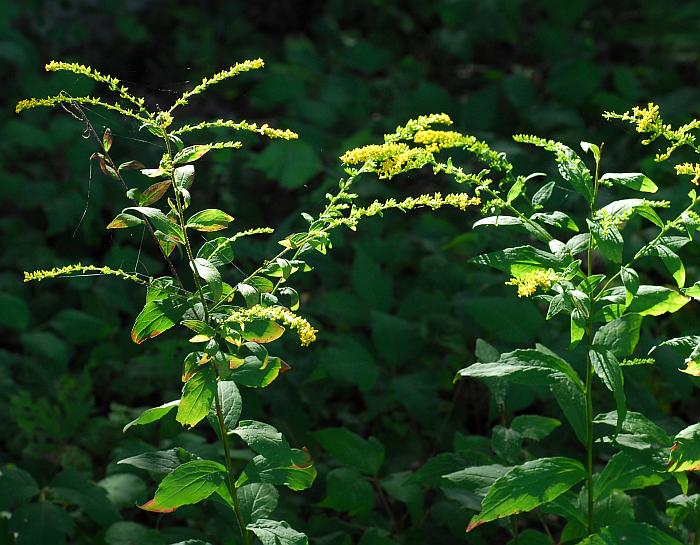Solidago ulmifolia var. ulmifolia
Elm-Leaved Goldenrod

Native
CC = 4
CW = 5
MOC = 71
© DETenaglia
Solidago ulmifolia var. ulmifoliaElm-Leaved Goldenrod | |
 |
Native CC = 4 CW = 5 MOC = 71 |
© DETenaglia |
|
Family - Asteraceae/Astereae Habit - Perennial forb, the rootstock short and often branched, not producing rhizomes. Stems - Ascending to erect, to 1.2 m, solitary to several, with several fine, longitudinal ridges or grooves, glabrous below the inflorescence or moderately pubescent with mostly spreading hairs 0.5-1.5 mm long, not shiny, not glaucous.
Leaves - Alternate, simple, basally disposed. Offsets usually absent. Basal and lowermost stem leaves with the blade 6-12 cm long, 2-5 cm wide, mostly 2-6 times as long as wide, elliptic to obovate or narrowly obovate, relatively thin, tapered relatively abruptly to a short to long, winged petiole at the base, angled or tapered to a sharply pointed tip, the margins sharply toothed and inconspicuously hairy, the surfaces sparsely to moderately pubescent with spreading or curved hairs, the upper surface often somewhat roughened to the touch, the undersurface with 1 main vein, the fine, pinnate secondary veins usually easily observed (these usually forming an irregular network). Median and upper stem leaves 1-6 cm long, elliptic to narrowly lanceolate, the margins toothed or those of the uppermost leaves entire, otherwise similar to the lower stem leaves.
Inflorescences - Open, more or less pyramidal panicles, the branches usually arched or nodding, the lowermost branches often relatively long, the heads oriented upward along the branches.
Heads - Involucre 2.5-4.0 mm long, the bracts in 3 or 4 unequal series. Involucral bracts oblong-ovate to narrowly oblong-lanceolate and bluntly to sharply pointed at the appressed-ascending tip, the thin, white to yellowish white margins hairy (at least toward the tip), the outer surface glabrous, with an elliptic or narrowly diamond-shaped, green to light green central region above the midpoint, this tapered gradually to the midvein, the midvein often slightly thickened and no additional veins present. Receptacle naked.
Florets - Ray florets 3-5, the corollas 1.5-2.0 mm long, yellow. Disc florets 4-7, the corollas 2.5-3.0 mm long, the lobes 0.5-0.9 mm long, yellow. Pappus 2.0-2.5 mm long, a few of the bristles often slightly thickened toward the tip.
Fruits - Achenes 1.0-1.6 mm long, narrowly obovoid, finely hairy. Flowering - August - November. Habitat - Mesic to dry upland forests, bluffs, glades, savannas, pond margins, acid seeps, streambanks, pastures, old fields, dry ditches, roadsides. Origin - Native to the U.S. Lookalikes - Many other goldenrods, but especially S. rugosa. Other info. - This is one of the most common goldenrods in Missouri, being found in woodlands throughout most of the state. Missouri and Illinois are at the center of its natural range, which extends northward into Wisconsin and New England and southward into Texas. The plant is recognized by its inflorescences of typically arching branches and its elliptic leaves with coarsely toothed margins. The small heads lined up along the inflorescence branches all point upward and have 3-5 ray florets each. Photographs taken at Shaw Nature Reserve, Franklin County, MO, 8-21-2021 (SRTurner). |